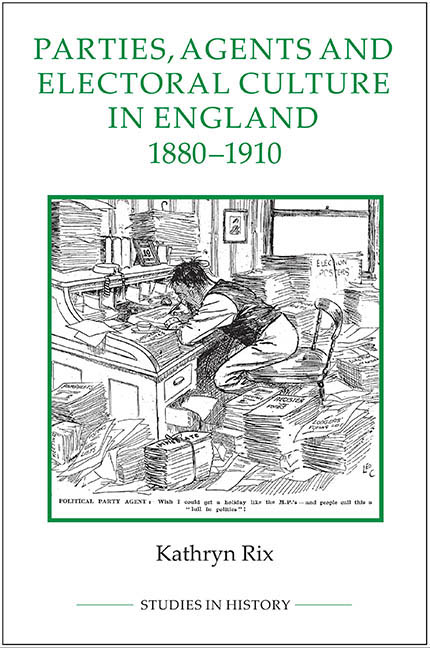Book contents
- Frontmatter
- Dedication
- Contents
- Tables
- Acknowledgements
- Abbreviations
- Introduction
- 1 The changing electoral system
- 2 The rise of the professional agent
- 3 The agents as aspiring professionals
- 4 The agents in the constituencies: registration and political education
- 5 The Agents in the Constituencies: The Social Side of Politics
- 6 Electioneering: the candidates
- 7 Electioneering: the campaign
- Conclusion
- Bibliography
- Index
7 - Electioneering: the campaign
Published online by Cambridge University Press: 13 April 2017
- Frontmatter
- Dedication
- Contents
- Tables
- Acknowledgements
- Abbreviations
- Introduction
- 1 The changing electoral system
- 2 The rise of the professional agent
- 3 The agents as aspiring professionals
- 4 The agents in the constituencies: registration and political education
- 5 The Agents in the Constituencies: The Social Side of Politics
- 6 Electioneering: the candidates
- 7 Electioneering: the campaign
- Conclusion
- Bibliography
- Index
Summary
Examining the election campaign in 1902, Ostrogorski outlined a ‘trilogy of electoral action’: the canvass, the ‘stump’ and election literature. Having receded into the background during the process of candidate selection, the agents now came to the fore in overseeing these key aspects of the campaign (and associated tasks such as conveying voters to the poll and hiring committeerooms). It was increasingly the case that the responsibility for acting as election agent – and ensuring that the election was conducted within the strict limits imposed by the Corrupt Practices Act – was given to the professional constituency agent. He superintended the volunteer activists who were a crucial part of electioneering after the 1883 reform. With the expanding electorate after 1885, much of the work of canvassing had to be delegated to them, although some candidates continued to make impressive efforts in this respect: George Kekewich personally visited 9,000 Exeter electors during his 1906 contest. It was, however, election meetings which provided the key opportunity for candidates to be seen and heard by voters. Recollecting that he ‘never canvassed anybody’ in his Bristol constituency, Augustine Birrell asserted that ‘in those days elections were merely speaking-matches’, a sentiment many contemporaries would have endorsed. Equally significant, though, in conveying the party message to voters was election literature, on which candidates spent copiously.
These two core strands of the campaign are examined here, exploring the evolution of electioneering between 1885 and 1910. Between these dates, central and regional party organisations dramatically expanded their provision of election speakers and election literature, aided in the latter by technological changes in mass printing, notably ‘the perfection of colour lithography, combined with the use of metal plates and offset printing’. Yet while it is relatively straightforward to delineate the quantities of resources which were supplied by party headquarters, what is more difficult to ascertain is how this was received in the constituencies and its qualitative impact on the campaign. This chapter will address these important questions, undertaking a detailed evaluation of the balance between central, regional and local provision, and seeking in particular to assess the effects which the influx of personnel and material from outside the constituency had on the local campaign. This detailed analysis of the interactions between local and national electoral cultures sheds new light on how the relationship between the parties and the people developed in the wake of the reforms of 1883–5.
- Type
- Chapter
- Information
- Parties, Agents and Electoral Culture in England, 1880-1910 , pp. 199 - 237Publisher: Boydell & BrewerPrint publication year: 2016

